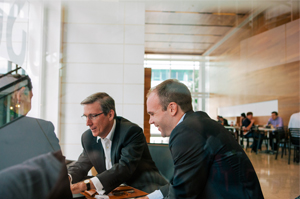The Project Owner is the person accountable for the success of the project.

The Project Executive is drawn from the business itself and views the project as a means to an end – the end being the benefits and outcomes that the project is designed to deliver. To the Project Executive, the project is an investment and that investment is only worthwhile while the benefits it will deliver outweigh the costs and risks of delivering those benefits. Hence, the Project Executive uses the business case as a constant source of reference. The Project Executive owns the business case because that describes the key parameters of the project for which they are accountable.
Project Executive – responsibility statement
- Primary accountability: To be accountable for the success of the project.
Establish the project’s governance arrangements
- Drive the initiation of the project upon appointment;
- Establish the Project Board and select Project Board members based on the project’s needs;
- Chair the Project Board;
- Recruit the Project Director and/or Project Manager;
- Establish the necessary stakeholder management groups;
- Ensure all stakeholders understand the operation of the project governance arrangements and their role in it;
- Ensure there is clarity of the decisions that are to be made by the Project Board.
Be the primary sponsor of the project
- Present themselves as the main face of the project both internally and external to the organisation;
- Manage stakeholders with the assistance of the Project Director and ensure stakeholders needs are met and their issues are addressed;
- Ensure ongoing stakeholder support for the project;
- Ensure stakeholders are aligned with the project’s objectives and that they remain so throughout the project;
Ensure the project maintains a service outcome focus
- Ensure the overall project focus is on delivering services and outcomes rather than only assets;
- Ensure project costing, budget and cost controls are focused on whole of life costs rather than only capital cost;
- Ensure the project benefits are clearly stated and that a clear plan is developed for realising those benefits;
- Develop the definition of the project from the owner’s perspective, ensuring clear articulation of the project’s benefits, objectives, drivers and critical success factors;
- Ensure the project focuses on benefits realisation throughout its life;
- Ensure the project remains aligned with the goals and vision of the organisation.
Monitor and control progress
- Ensure the project follows the organisation’s approved project management methodology;
- Drive the project forward and ensure that momentum and progress is maintained;
- Own and manage the project budget;
- Where additional funds are required, present or support the case for such funds;
- Own and manage the project business case and other key project documentation such as the project plan, preliminary business case or equivalent;
- Ensure project documentation is reviewed by the Project Board and that documents are either approved or the necessary modifications required to achieve approval are articulated;
- Approve, or otherwise, material scope changes and ensure the business case reflects such changes.
Focus on the main risks and issues
- Ensure adequate attention is focused on risks and risk mitigation;
- Where appropriate, ensure risk mitigation is adequately costed;
- Resolve issues that have been escalated by the Project Manager and work with stakeholders where necessary to address such issues;
- Where necessary, seek independent advice on the project;
- Ensure adequate assurance mechanisms have been established.
Resource the project for success
- Ensure adequate Project Executive resources are allocated to the project to assist in defining service delivery outcomes, desired benefits, output specification etc;
- Ensure sufficient user resources are deployed on the project for the production of user specifications, acceptance criteria etc;
- Ensure external supplier resources are adequate both in terms of numbers, skills and expertise;
- Ensure they allocate adequate of their own time to the project.
Maintain a strategic perspective on the project
- Liaise with the program management office (if extant) regarding resourcing, quality criteria and the positioning of the project as part of the broader program;
- Understand the strategic objectives of the organisation and ensure the project remains aligned with those objectives throughout its life;
- Maintain awareness of the any broader environmental (not just green) considerations and how the project impacts upon or could be impacted by such considerations;
- Balance the sometimes conflicting views and needs of the business, users and suppliers;
- Attend Program Board meetings of the overarching program of which their project is a component.